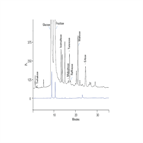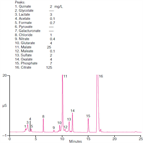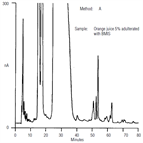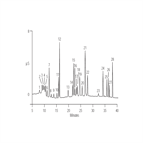Find methods for your needs
Refine by Feature
Displaying 1-5 of 5 results for Tag: Adulteration
CAN123: Sugars in Honey Using HPAE-PAD: What Is the Best Column?
Instrument Type: ICHoney is defined by the Codex Alimentarius as the natural, sweet substance produced by honey bees from the nectar of plants or from secretions of living parts of plants or excretions of plant sucking insects on the living parts of plants, which the bees collect, transform by combining with specific substances of their own, deposit, dehydrate, store and leave in the honeycomb to ripen and mature. High-performance anion-exchange chromatography with pulsed amperometric detection is commonly used to determine the carbohydrates in honey. This document evaluates CarboPac columns for that purpose.
Validated Method for the Determination of Phenylbutazone in Horse Meat with LC-MS/MS
Instrument Type: LCMSMSPhenylbutazone (bute, PBT) is one of the most widely used (non-steroidal) anti-inflammatory (NSAiD) and painkiller drug for dogs and horses. Horse meat is still widely used for human consumption in some European countries. For those animals marked for human consumption, a limited number of medicines can be administered. A newly developed LC-MS/MS method for the determination of PBT in horse meat with LC-MS/MS is described here. The method was validated in-house and its applicability for routine testing was tested following the European legislation requirements.
AB137: Determination of Inorganic and Organic Acids in Apple and Orange Juice Samples Using Capillary IC
Instrument Type: ICDeterminations of organic acids in fruit juices are used by the beverage industry for flavor characterization, identification of spoilage, identification of adulteration by a less costly juice, and product labeling. In this study, inorganic anions and organic acids in diluted filtered apple and orange juice samples were determined on a Dionex IonSwift MAX-100 anion-exchange column using electrolytically generated hydroxide gradient from 0.1–65 mM KOH over 25 min at 15 μL/min.
AN82: Analysis of Fruit Juices Adulterated with Medium Invert Sugar from Beets (Method B).
Instrument Type: ICFruit juice adulteration presents an economic & regulatory problem. Investigators using high performance anion exchange chromatography with pulsed amperometric detection (HPAE-PAD) discovered several components in beet medium invert sugar(BMIS) that are not present in orange juice. The selectivity of anion-exchange chromatography, especially for oligosaccharides, the sensitivity and specificity of pulsed amperometric detection make HPAE-PAD uniquely suited to this analysis. Today we would use a different electrochemical waveform (see TN21) and post-column addition of NaOH would not be required
AN143: Determination of Organic Acids in Fruit Juices
Instrument Type: ICThis application note shows how organic acids can be determined in fruit juices at low to high mg/L concentrations using a simple dilution, an IonPac AS11-HC, electrolytically generated eluent gradients, and suppressed conductivity detection. The fruit juices analyzed in this application note are orange, grape, apple, and cranberry.





